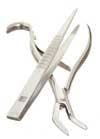Tracking surgical instruments
One of the main challenges facing hospitals today is the need to monitor and control the vast range of instruments currently used in modern surgical procedures. Sterilization of instruments is currently managed on a batch basis: There is no means of identifying and tracing an individual item as it is used, sterilized, and stored within the hospital. As newer, more complex surgical interventions are developed and the diversity of instruments increases there is an urgent need for an automated means of identifying and tracing individual instruments as they move through the system.
Now a computerized system developed by Servo Software Systems (Peterborough, England) in conjunction with laser systems specialists Electrox (Letchworth, England), offers a solution.
The combination of Servo's software expertise and laser marking technology from Electrox will allow specific instruments to be traced throughout the cleansing system. Most importantly the system will identify instruments as they both enter and leave an operating theatre and provide a precise count of the instruments used as well as detect any possible loss of an instrument—either in the theatre or the patient—during the operation.
The system employs an Electrox marking laser to put an indelible mark directly onto the surface of each instrument in the form of a data matrix code—a high-capacity, two-dimensional symbology—which is read by a hand-held scanner to access and maintain the historical information related to that instrument held on a central database supplied by Servo. This database can then be used to audit instrument usage and life.
Laser marking is a non-intrusive process, creating a high-contrast image without the use of acids or solvents or indentations that might provide localized sites for contaminants. The laser-marked data matrix code is permanent and resilient to innumerable passes through the hospital's cleansing unit.
A recent trial carried out at Pontefract Hospital in West Yorkshire, England, showed that each instrument can be successfully marked in less than three seconds. Any items too small to be marked directly or which are manufactured from an incompatible substrate can be permanently marked on a tag that is attached to the instrument.
Health regulations in the United Kingdom already require sterile service departments (SSDs) to be able to trace all instrument trays to both the manufacturing process and the patients on which they were subsequently used, but Pontefract Hospital decided to go beyond the current legislation and track all individual and supplementary instruments.
Having used Servo Software's SSDman software for many years Pontefract Hospital purchased the module Servo had developed for SSDman to track instruments and to lease, with qualified personnel from Electrox, a diode-pumped laser marking system.
Initial tests were carried out on obsolete instruments to establish the correct laser settings and to ensure that the process did not damage the instrument's surface. Once established, it was found that these basic settings covered a large proportion of all instruments new and old.
Marking took place over a four-day period when all the instruments for the theatre block were marked. Of the 1000 plus instruments marked only 60 were found to be unsatisfactory. These were sent to an instrument repair contractor to have the mark polished out ready for re-marking. It was found that prompt processing after application of the mark prevented corrosion or tarnish within the mark. To date, Pontefract Hospital has noticed no detrimental effect to any of the instruments marked, many of which are used and processed daily.
At Pontefract scanning the data matrix code provides an image of the instrument itself alongside all information relative to that device. In normal daily use the staff does not need to use either keyboard or mouse, and this has contributed greatly to their acceptance of the system as well as providing a valuable training tool at the point of use.
Within the context of the current cleansing regime each surgical unit tends to have its own sterilization facility on site, but with this kind of enhanced tracking system hospitals can now contemplate sharing sterilizing capacity between several sites and benefit from the economies of scale that a centralized resource could bring.
As well as the obvious benefit of tracing specific instruments to procedures carried out on individual patients, this new system has the ability to monitor the value of the stock of instruments owned by a hospital.
Permanent identification of instruments also enables a hospital to determine whether an item sent for repair outside the hospital under warranty has been returned or replaced.
Pontefract Hospital is the first hospital in the United Kingdom to investigate this application and Angela Fairbank, sterile services manager at Pontefract, says, "We are greatly encouraged by the trials of the system. The permanent quality of the marking met our expectations and the information available via the instrument database offers real advances in patient care and safety."
Malcolm Payne is with Electrox (Letchworth, England) and Terry Watson is with Servo (Peterborough, England). Call Electrox at 44 1462 472400 or Servo at 44 1733 372700.

